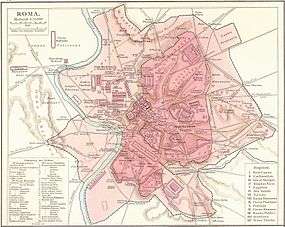Temple of Vesta
Coordinates: 41°53′30″N 12°29′11″E / 41.891664°N 12.486262°E
| Temple of Vesta | |
|---|---|
.jpg) Remains of the Temple of Vesta | |
| Location | Regione VIII Forum Romanum |
| Built in | unknown old Kingdom era |
| Built by/for | Unknown builder |
| Type of structure | Roman Old kingdom |
| Related |
List of ancient monuments in Rome |
 Temple of Vesta | |
The Temple of Vesta (Latin Aedes Vestae, Italian Tempio di Vesta) is an ancient edifice in Rome, Italy, located in the Roman Forum near the Regia and the House of the Vestal Virgins. The temple's most recognizable feature is its circular footprint. Since the worship of Vesta began in private homes, the architecture seems to be a reminder of its history. The extant temple used Greek architecture with Corinthian columns, marble, and a central cella. The remaining structure indicates that there were twenty Corinthian columns built on a podium fifteen meters in diameter. The roof probably had a vent at the apex to allow smoke release.

History

All temples to Vesta were round, and had entrances facing east to symbolize connection between Vesta’s fire and the sun as sources of life. The Temple of Vesta represents the site of ancient cult activity as far back as 7th century BCE. Numa Pompilius is believed to have built this temple along with the original Regia and House of the Vestal Virgins in its original form. Around the Temple stood The Sacred Grove, in which also there was a graveyard for the priests and virgins.[1]
It was one of the earliest structures located in the Roman Forum although its present reincarnation is the result of subsequent rebuilding. Instead of a cult statue in the cella there was a hearth which held the sacred flame. The temple was the storehouse for the legal wills and documents of Roman Senators and cult objects such as the Palladium. The Palladium was a statue of Athena (Roman Minerva) believed to have been brought by Aeneas from Troy; the statue was felt to be one of the Pignora Imperii, or pledges of imperium, of Ancient Rome. According to Dionysius of Halicarnassus, the Romans believed that the Sacred fire of Vesta was closely tied to the fortunes of the city and viewed its extinction as a portent of disaster.
Reconstructions
Although there was a fire in the temple, it did not pose a great risk to burning down since the fire was maintained in a hearth and watched closely by the Vestals. Rather, the city of Rome itself was often the source of conflagration that destroyed the temple. The Temple of Vesta burned twice in written history. In 64 CE, the Great Fire of Rome burned most of Rome, including the Temple of Vesta. It was said by Cassius Dio to have been started by the infamous Nero, but according to Tacitus, Nero was at Antium at the time of the fire. After a fire in 191, Julia Domna, the wife of Septimius Severus, had the temple restored. The sacred flame was put out in 394 by Theodosius I after he won the Battle of the Frigidus, defeating Eugenius and Arbogast.
The Temple of Vesta remained reasonably intact until the Renaissance. However, in 1549, the building was completely demolished and its marble reused in churches and papal palaces. The section standing today was reconstructed in the 1930s during the dictatorship of Benito Mussolini.
See also
- The round Temple of Hercules Victor in the Forum Boarium was initially thought to be a temple of Vesta.
- The Temple of Vesta, Tivoli.
References
- ↑ Charlotte Anne Eaton, Rome in the Nineteenth Century - 1822 "At the base of the Palatine Hill, surrounded with the Sacred Grove, and enclosed with a wall, stood the Temple of Vesta, and the House of the Vestal Virgins, to which the Regia of Numa served as a portico."